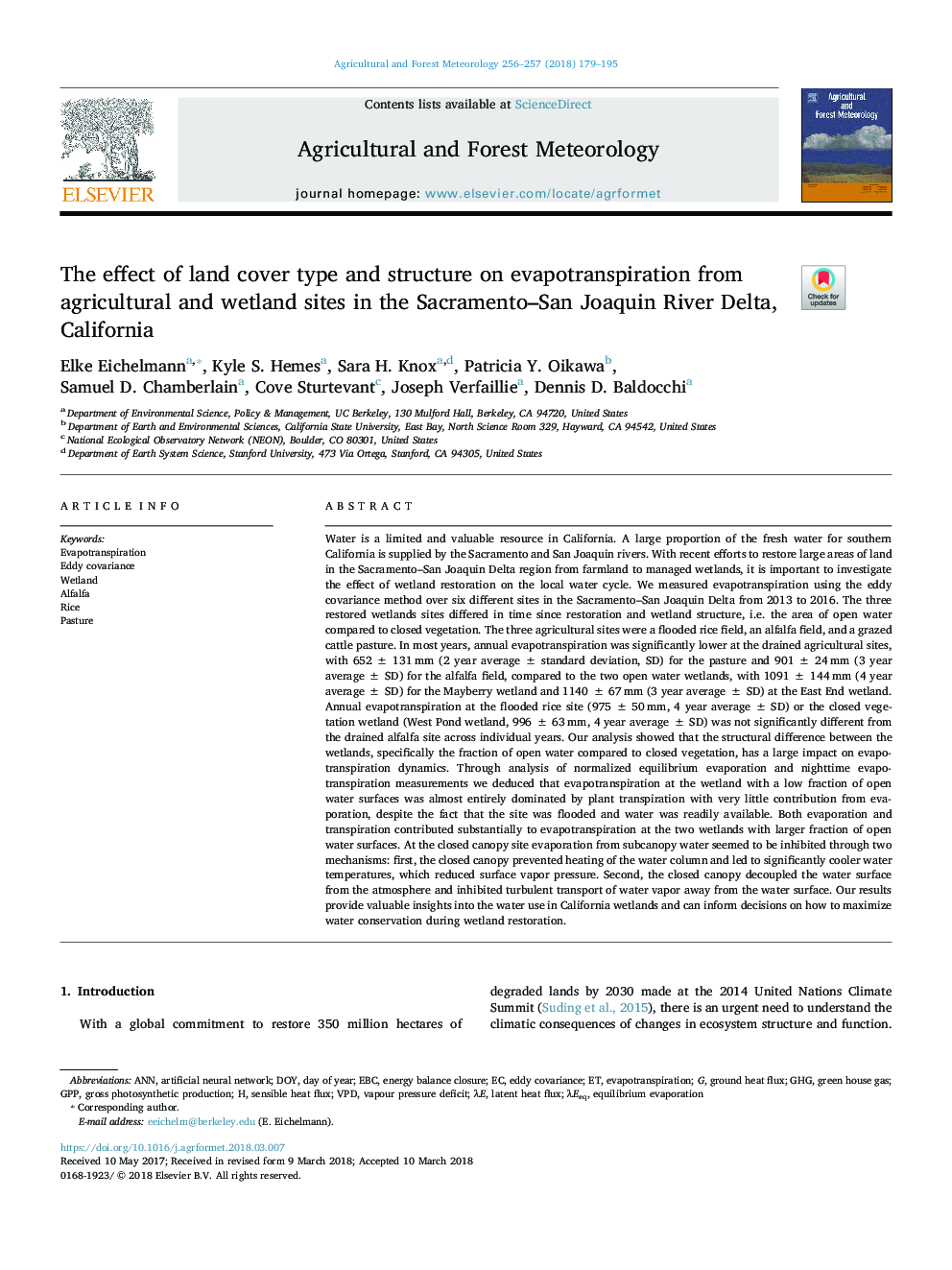| کد مقاله | کد نشریه | سال انتشار | مقاله انگلیسی | نسخه تمام متن |
|---|---|---|---|---|
| 6536691 | 1420847 | 2018 | 17 صفحه PDF | دانلود رایگان |
عنوان انگلیسی مقاله ISI
The effect of land cover type and structure on evapotranspiration from agricultural and wetland sites in the Sacramento-San Joaquin River Delta, California
دانلود مقاله + سفارش ترجمه
دانلود مقاله ISI انگلیسی
رایگان برای ایرانیان
کلمات کلیدی
ANNGHGVPDGPPEBCDOY - انجام دهیدRice - برنجWetland - تالابEvapotranspiration - تبخیر و تعرقEnergy balance closure - تعادل انرژی تعادلday of year - روز سالGround heat flux - شار حرارتی زمینSensible heat flux - شار حرارتی معقولLatent heat flux - شار گرما نهانArtificial Neural Network - شبکه عصبی مصنوعیPasture - مرتعvapour pressure deficit - کسری فشار بخارEddy covariance - کوواریانس اودیGreen house gas - گاز گلخانه ایAlfalfa - یونجه
موضوعات مرتبط
مهندسی و علوم پایه
علوم زمین و سیارات
علم هواشناسی
پیش نمایش صفحه اول مقاله

چکیده انگلیسی
Water is a limited and valuable resource in California. A large proportion of the fresh water for southern California is supplied by the Sacramento and San Joaquin rivers. With recent efforts to restore large areas of land in the Sacramento-San Joaquin Delta region from farmland to managed wetlands, it is important to investigate the effect of wetland restoration on the local water cycle. We measured evapotranspiration using the eddy covariance method over six different sites in the Sacramento-San Joaquin Delta from 2013 to 2016. The three restored wetlands sites differed in time since restoration and wetland structure, i.e. the area of open water compared to closed vegetation. The three agricultural sites were a flooded rice field, an alfalfa field, and a grazed cattle pasture. In most years, annual evapotranspiration was significantly lower at the drained agricultural sites, with 652â¯Â±â¯131â¯mm (2 year averageâ¯Â±â¯standard deviation, SD) for the pasture and 901â¯Â±â¯24â¯mm (3 year averageâ¯Â±â¯SD) for the alfalfa field, compared to the two open water wetlands, with 1091â¯Â±â¯144â¯mm (4 year averageâ¯Â±â¯SD) for the Mayberry wetland and 1140â¯Â±â¯67â¯mm (3 year averageâ¯Â±â¯SD) at the East End wetland. Annual evapotranspiration at the flooded rice site (975â¯Â±â¯50â¯mm, 4 year averageâ¯Â±â¯SD) or the closed vegetation wetland (West Pond wetland, 996â¯Â±â¯63â¯mm, 4 year averageâ¯Â±â¯SD) was not significantly different from the drained alfalfa site across individual years. Our analysis showed that the structural difference between the wetlands, specifically the fraction of open water compared to closed vegetation, has a large impact on evapotranspiration dynamics. Through analysis of normalized equilibrium evaporation and nighttime evapotranspiration measurements we deduced that evapotranspiration at the wetland with a low fraction of open water surfaces was almost entirely dominated by plant transpiration with very little contribution from evaporation, despite the fact that the site was flooded and water was readily available. Both evaporation and transpiration contributed substantially to evapotranspiration at the two wetlands with larger fraction of open water surfaces. At the closed canopy site evaporation from subcanopy water seemed to be inhibited through two mechanisms: first, the closed canopy prevented heating of the water column and led to significantly cooler water temperatures, which reduced surface vapor pressure. Second, the closed canopy decoupled the water surface from the atmosphere and inhibited turbulent transport of water vapor away from the water surface. Our results provide valuable insights into the water use in California wetlands and can inform decisions on how to maximize water conservation during wetland restoration.
ناشر
Database: Elsevier - ScienceDirect (ساینس دایرکت)
Journal: Agricultural and Forest Meteorology - Volumes 256â257, 15 June 2018, Pages 179-195
Journal: Agricultural and Forest Meteorology - Volumes 256â257, 15 June 2018, Pages 179-195
نویسندگان
Elke Eichelmann, Kyle S. Hemes, Sara H. Knox, Patricia Y. Oikawa, Samuel D. Chamberlain, Cove Sturtevant, Joseph Verfaillie, Dennis D. Baldocchi,